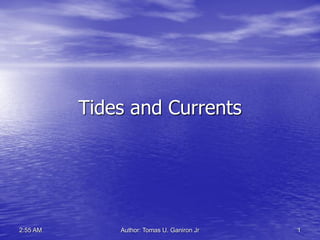Recommended
More Related Content
What's hot
What's hot (20)
East Coast MARE Ocean Lecture May 16, 2012 - Surf's Up! All About Waves at th...

East Coast MARE Ocean Lecture May 16, 2012 - Surf's Up! All About Waves at th...
Similar to Tides and Currents
Similar to Tides and Currents (20)
Ocean Current for students of class 9 and 10 ICSe board best presentation on ...

Ocean Current for students of class 9 and 10 ICSe board best presentation on ...
a7kXImOPZCYbj5962SdaKwzrsdGjXqauxsBW6lJn (1) (1) (1) (1).pptx

a7kXImOPZCYbj5962SdaKwzrsdGjXqauxsBW6lJn (1) (1) (1) (1).pptx
More from haroldtaylor1113
More from haroldtaylor1113 (20)
Case Study No. 9-Philippines’ Integrated Stormwater Management

Case Study No. 9-Philippines’ Integrated Stormwater Management
Case Study No. 1-Groundwater Supply of Cavite Province

Case Study No. 1-Groundwater Supply of Cavite Province
Case Study No. 11- Hydroelectric Power Plant in the Philippines

Case Study No. 11- Hydroelectric Power Plant in the Philippines
Case Study No. 10-Construction of Box Culverts in the Philippines

Case Study No. 10-Construction of Box Culverts in the Philippines
Case Study No. 6-Road and Drainage Improvement Project in Caloocan City

Case Study No. 6-Road and Drainage Improvement Project in Caloocan City
Case Study No. 5-Pasig River Open Channel in Aquaculture

Case Study No. 5-Pasig River Open Channel in Aquaculture
Case Study No. 4-Design of Water Distribution System using Naugong spring as ...

Case Study No. 4-Design of Water Distribution System using Naugong spring as ...
Case Study 13-A Color for All Seasons & A New Variety of Success

Case Study 13-A Color for All Seasons & A New Variety of Success
Case Study 12A-From Herbal Folklore to Modern Medicine 

Case Study 12A-From Herbal Folklore to Modern Medicine
Case Study 11-Rising Above the Competition & Thriving on IP Protection 

Case Study 11-Rising Above the Competition & Thriving on IP Protection
Case Study 10-Shaping a Regional IP Tool & Folk Art and the Opportunities of ...

Case Study 10-Shaping a Regional IP Tool & Folk Art and the Opportunities of ...
Case Study 8-Electrifying Economic Development & From Heavy to Light_Accelera...

Case Study 8-Electrifying Economic Development & From Heavy to Light_Accelera...
Case Study 9-Strategic Partnership Linked to IP in the Development & Planting...

Case Study 9-Strategic Partnership Linked to IP in the Development & Planting...
Case Study 7- A Bold Step into the Modern Economy & A Remote Solution for a G...

Case Study 7- A Bold Step into the Modern Economy & A Remote Solution for a G...
Tides and Currents
- 1. Tides and Currents 2:55 AM Author: Tomas U. Ganiron Jr 1
- 2. Tides • are the cyclic rising and falling if Earth’s ocean surface caused by the tidal forces of the Moon and the Sun acting on the oceans. The changing tide produced at a given location is the result of the changing positions of the Moon and Sun relative to the Earth coupled with the effects of the Earth’s rotation. 2:55 AM Author: Tomas U. Ganiron Jr 2
- 3. Intertidal zone • Is the strip of seashore that is submerged at high tide and exposed at low tide. 2:55 AM Author: Tomas U. Ganiron Jr 3
- 4. A tide is a repeated cycle of sea level changes in the following stages: • Over several hours the water rises or advances up a beach in the flood tide. • The water reaches its highest level and stops at high tide. Because tidal currents cease this is also called slack water or slack tide. The tide reverses direction and is said to be turning. • The sea level recedes or falls over several hours during the ebb tide. • The level stops falling at low tide. This point is also described as slack or turning. Tides may be semidiurnal (two high tides and two low tides each day), or diurnal (one tidal cycle per day). 2:55 AM Author: Tomas U. Ganiron Jr 4
- 5. • The various frequencies of astronomical forcing which contribute to tidal variations are called constituents. Its period is about 12 hours and 24 minutes, exactly half a tidal lunar day, the average time separating one lunar zenith from the next, and thus the time required for the Earth to rotate once relative to the Moon. • The changing distance of the Moon from the Earth also affects tide heights. When the Moon is at perigee the range is increased and when it is at apogee the range is reduced. Every 7½ lunations, perigee coincides with either a new or full moon causing perigean tides with the largest tidal range 2:55 AM Author: Tomas U. Ganiron Jr 5
- 6. Current • A current, in a river or stream, is the flow of water influenced by gravity as the water moves downhill to reduce its potential energy. The current varies spatially as well as temporally within the stream, dependent upon the flow volume of water, stream gradient, and channel geometrics. 2:55 AM Author: Tomas U. Ganiron Jr 6
- 7. Ocean current • is any more or less continuous, directed movement of ocean water that flows in one of the Earth's oceans. • Ocean Currents are rivers of hot or cold water within the ocean. The currents are generated from the forces acting upon the water like the earth's rotation, the wind, the temperature and salinity differences and the gravitation of the moon. • Ocean currents can flow for thousands of kilometers. They are very important in determining the climates of the continents, especially those regions bordering on the ocean. 2:55 AM Author: Tomas U. Ganiron Jr 7

